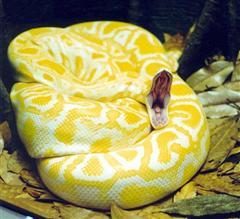Python - Burmese
Scientific Name: Python moluris bivittatus
Sat, 19th July, 2025 - 9:50 pm GMT
Sponsor Ads:

Alternative Name
Scientific Name: Python moluris bivittatusBasic Info
An immensely large snake, the Burmese Python averages around 16 feet in length. It should be noted that females can, and often do grow even larger than this. Males are smaller and usually average between 9 and 13 feet in length. Some specimens have been recorded at lengths of up to twenty-five feet. The Burmese Python has a vibrant pattern, mostly in shades of brown and gold. The patches are usually outlined in a lighter color. The background color of the body is usually gray, yellowish-brown, and tan. Like many Pythons, the Burmese Python has two small spurs near its tail that are the remains of prehistoric legs. Burmese Pythons are quite popular as pets. At least, they are popular until they grow to eight or ten feet long, at which point many owners abandon them to veterinarians or animal shelters.
Health
Large adult Burmese Pythons will require large food items that may be expensive and difficult to procure year round. Though some people feed their pythons chickens, this is not recommended because of the risk of spreading salmonella to the snake. Like other snakes it may be better to feed in a different enclosure than the one they live in to prevent the snake from associating you with food and biting you. Burmese Pythons are prone to Inclusion Body Disease. It is a fatal disease and all new Pythons should be carefully examined for the disease before introducing it to other animals. Burmese Pythons grow very quickly and a full-grown Burmese Python requires a huge amount of room. Many people convert large walk-in closets into Python homes. Burmese Pythons are capable of producing a huge amount of feces and urine and the enclosure should be cleaned often. The Python should be provided with a place to hide such as a log or upside-down cardboard box. Larger snakes will likely require hand-built enclosures. The Burmese Python should always have access to a large water dish to drink from and soak in. They tend to defecate in their water, so it may need to be cleaned often. The Burmese Python should be kept at a temperature of about 85 degrees Fahrenheit during the day, and between 75 and 80 degrees at night. They should also have a daytime basking area of around 90 degrees Fahrenheit. Breeding Female Burmese Pythons will lay a clutch of between 8 and 100 eggs, about three months after she mates with a male. She coils her body around the eggs and incubates them for between two and three months, keeping them warm with muscular contractions. The muscle contractions keep the eggs a few degrees above the ambient temperature. Hatchling Burmese Pythons suffer a great deal from predators, when young. However, they grow very quickly and the surviving babies quickly reach the size where few animals are a threat.Habitat
N/ABehavior
The Burmese Python is one of the largest snakes alive today. Though they can be docile animals, especially if handled often from a young age, the Burmese Python can also be quite aggressive and very dangerous. There are a large number of homeless Burmese Pythons in the United States because people do not realize the responsibility of keeping a giant Python. Ownership of a Burmese Python is not something to be entered into lightly.Because of the very flexible jaw of the Burmese Python, they can swallow things several times the size of their head. Burmese Pythons find their prey using their excellent sense of smell along with the heat sensors along their upper lips. When handled from a young age, the Burmese Python can be quite tolerant of handling. Burmese Pythons must be handled regularly, even as they grow quite large, to remain tame. When handling a Burmese Python, especially a larger one, more than one person should be present. Burmese Pythons are diurnal, meaning they are active during the day. They spend most of the day basking in the sun.Origin
Indo-PacificHistory
The Burmese Python can be found on Asia and surrounding islands. They are semi-aquatic, meaning they spend quite a lot of their time in water.Common Foods
The Burmese Python feeds on birds, reptiles, frogs, fish, and mammals in the wild.Sponsor Ads:
I am convinced that if we are to get on the right side of the world revolution, we as a nation must undergo a radical revolution of values. We must rapidly begin the shift from a thing-oriented society to a person-oriented society. When machines and computers, profit motives and property rights, are considered more important than people, the giant triplets of racism, extreme materialism, and militarism are incapable of being conquered. -- Martin Luther King
Python - Burmese
Coded by: BGID® | ALL RIGHTS RESERVED Copyright © 2000-2025
Disclaimer | Privacy | Report Errors / Contact | Credits








 President of the United States of America - Real Estate mogul, Pageant owner and now one of the most controversial men in political history.
President of the United States of America - Real Estate mogul, Pageant owner and now one of the most controversial men in political history.  Global warming has been in and out as the "latest" hot topic for many years. It is, according to modern scientists, the result of man-made industrial pollutants, clearing forested areas, agriculture, etc. But now they are thinking it started way before the Industrial Revolution...
Global warming has been in and out as the "latest" hot topic for many years. It is, according to modern scientists, the result of man-made industrial pollutants, clearing forested areas, agriculture, etc. But now they are thinking it started way before the Industrial Revolution...  Politician, US Vice President and President of the USA - Joseph Robinette Biden Jr.
Politician, US Vice President and President of the USA - Joseph Robinette Biden Jr.  versus
versus  Russia: 'The Evil Empire'? Are they all that bad or is it just the USA trying to portray Russia as bad because they are a world power with land bigger and a society very different from the USA ideal?
Russia: 'The Evil Empire'? Are they all that bad or is it just the USA trying to portray Russia as bad because they are a world power with land bigger and a society very different from the USA ideal? 
 Corona virus
Corona virus 
 Users with wide screen monitors can benefit from more content on every page.
Users with wide screen monitors can benefit from more content on every page.